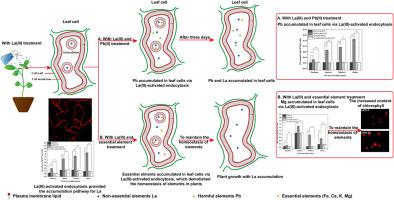Ecotoxicology and Environmental Safety ( IF 6.2 ) Pub Date : 2021-06-17 , DOI: 10.1016/j.ecoenv.2021.112429 Yue Ben 1 , Mengzhu Cheng 1 , Lihong Wang 2 , Qing Zhou 2 , Zhenbiao Yang 3 , Xiaohua Huang 1

|
Rare earth elements (REEs) are emerging as a serious threat to ecological safety due to their increasing accumulation in environments. The accumulation of REEs in environments has significantly increased its accumulation in the leaves of edible plants. However, the accumulation pathway of REEs in the leaves of edible plants are still unknown. In this study, lanthanum [La(III), a widely used and accumulated REE] and four edible plants (soybean, lettuce, pakchoi, and celery) with short growth cycles were selected as research objects. By using interdisciplinary research techniques, we found that low-dose La(III) activated endocytosis (mainly the clathrin-mediated endocytosis) in the leaf cells of four edible plants, which provided an accumulation pathway for low-dose La in the leaf cells of these edible plants. The accumulation of La in the leaf cells was positively correlated with the intensity of endocytosis, while the intensity of endocytosis was negatively correlated with the density of leaf trichomes. In addition to the accumulation of La, low-dose La(III) also brought other risks. For example, the harmful element (Pb) can also be accumulated in the leaf cells via La(III)-activated endocytosis; the homeostasis of the essential elements (K, Ca, Fe, Mg) was disrupted, although the chlorophyll synthesis and the growth of these leaf cells were accelerated; and the expression of stress response genes (GmNAC20, GmNAC11) in soybean leaves was increased. These results provided an insight to further analyze the toxicity and mechanism of REEs in plants, and sounded the alarm for the application of REEs in agriculture.
中文翻译:

低剂量镧激活内吞作用,加剧镧或/和铅的积累并破坏四种可食用植物叶细胞中必需元素的稳态
稀土元素(REEs)由于在环境中的积累越来越多,正在成为对生态安全的严重威胁。环境中稀土元素的积累显着增加了其在食用植物叶片中的积累。然而,可食用植物叶片中稀土元素的积累途径尚不清楚。本研究选择镧[La(III),一种广泛使用和积累的稀土元素]和四种生长周期较短的食用植物(大豆、生菜、小白菜和芹菜)作为研究对象。通过跨学科研究技术,我们发现低剂量 La(III) 激活了四种食用植物叶细胞中的内吞作用(主要是网格蛋白介导的内吞作用),这为低剂量 La(III) 在植物叶细胞中的积累提供了一条途径。这些可食用的植物。La在叶细胞中的积累与内吞强度呈正相关,而内吞强度与叶毛状体密度呈负相关。除了La的积累,低剂量的La(III)还带来了其他风险。例如,有害元素(Pb)也可以通过 La(III)激活的内吞作用在叶细胞中积累;尽管叶绿素合成和这些叶细胞的生长加速,但必需元素(K、Ca、Fe、Mg)的稳态被破坏;以及应激反应基因的表达(有害元素 (Pb) 也可以通过 La(III) 激活的内吞作用在叶细胞中积累;尽管叶绿素合成和这些叶细胞的生长加速,但必需元素(K、Ca、Fe、Mg)的稳态被破坏;以及应激反应基因的表达(有害元素 (Pb) 也可以通过 La(III) 激活的内吞作用在叶细胞中积累;尽管叶绿素合成和这些叶细胞的生长加速,但必需元素(K、Ca、Fe、Mg)的稳态被破坏;以及应激反应基因的表达(大豆叶中的GmNAC20、GmNAC11 ) 增加。这些结果为进一步分析稀土元素在植物中的毒性和作用机制提供了思路,为稀土元素在农业中的应用敲响了警钟。











































 京公网安备 11010802027423号
京公网安备 11010802027423号